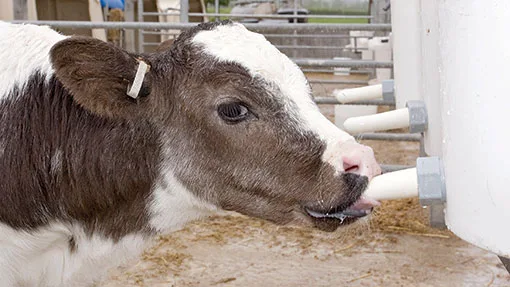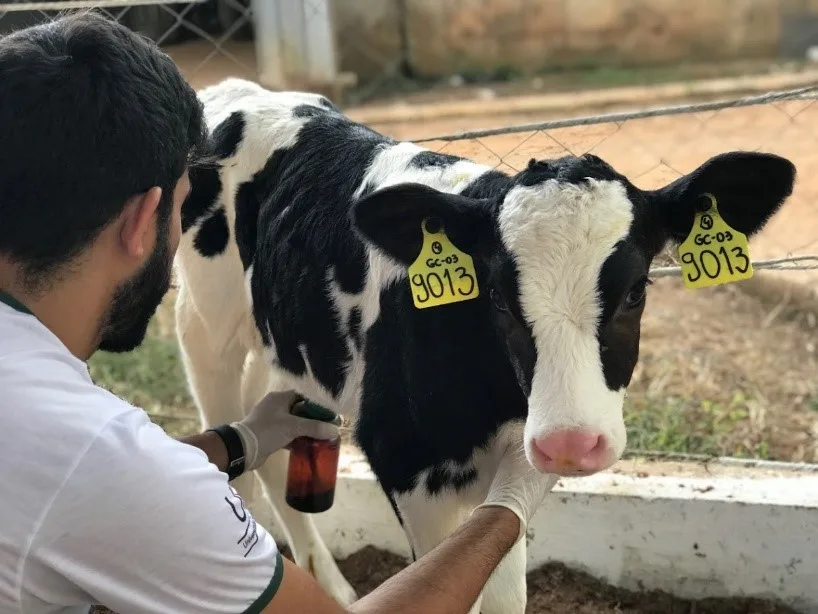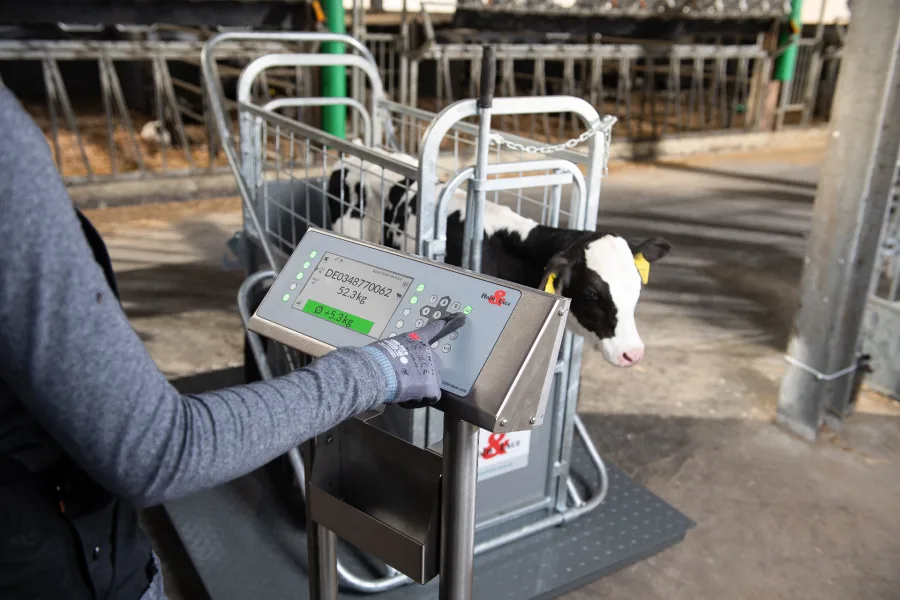Vaccines alone won’t save your calves! Poor management trumps even the best shots. Fix your program before losing $260+/heifer in milk.
EXECUTIVE SUMMARY: Calf vaccination programs often fail because producers treat vaccines as magic bullets while neglecting foundational management. Key issues include poor colostrum practices, mistimed vaccinations (ignoring maternal antibody interference), and generic protocols that don’t address farm-specific pathogens. Research shows disease-stressed calves produce 260+ lbs less milk in first lactation and face higher mortality. The fix? Integrate strategic dam/calf vaccination timing, rigorous colostrum management, and diagnostic-driven protocols. True herd resilience requires marrying vaccines with bulletproof management-neither works alone.
KEY TAKEAWAYS:
- Colostrum is non-negotiable: Fail the “5 Qs” (Quality, Quantity, Quickness, Cleanliness, Temperature), and vaccines become wasted money.
- Vaccine timing matters more than the vial: Maternal antibodies block early vaccines; intranasal options bypass this but require boosters.
- Diagnostics > guesswork: Farm-specific pathogen testing prevents over-vaccinating while targeting real threats.
- Silent carriers sink herds: 17-50% of calves born to Salmonella Dublin carriers get infected-vaccinate dams to cut risk 5x.
- Integration beats innovation: Combine colostrum, housing, diagnostics, and strategic vaccination. No single solution fixes poor management.

The hard truth no one else will tell you: Your calf vaccine program is built on quicksand. Like putting premium semen in a cow with metritis, vaccination without rock-solid management is money wasted. Research proves calves struggling with pre-weaning disease produce 260 pounds less milk in first lactation, and thousands of dollars in lifetime revenue vanish. It’s time to demolish your failing approach and rebuild from the ground up.
“The solution to poor management usually does not come in a bottle. Vaccines are just one of the tools we must prevent diseases; they will not overcome poor management. They are not a magic bullet.”
Dr. Angel Abuelo of Michigan State University dropped this truth bomb at the Great Lakes Regional Dairy Conference. His statement cuts through the fog of misconception, costing dairy producers millions collectively in wasted vaccine spending and preventable calf losses.
Let’s face facts: despite decades of scientific advancement and increasingly sophisticated vaccines, the needle hasn’t moved much on calf health statistics. The National Animal Health Monitoring System reports calf morbidity and mortality rates stubbornly hovering around 33.9% and 5%, respectively. These numbers aren’t just disappointing – they’re a damning indictment of the industry’s approach to calf health.
Are you investing in premium vaccines while cutting corners on colostrum delivery, housing, or nutrition? If so, you’re essentially throwing money down the drain – like buying genomically elite embryos, then raising the resulting heifers on cheap commodity feed. The science is clear: vaccination effectiveness depends entirely on the foundation you’ve built through management.
The Hidden Cost of Calf Disease You Can’t Afford to Ignore
Here’s what should keep you up at night: heifers battling diarrhea or respiratory disease during those critical pre-weaning weeks are 10-14% less likely to reach their first calving, show 5% reduced conception rates, and produce approximately 260 pounds less milk during first lactation. With today’s milk prices hovering near $20/cwt, that’s a financial hit that compounds with every affected animal.
These aren’t just statistics – they represent real dollars walking out your freestall barn door. Even more concerning, these performance gaps aren’t temporary; they’re permanently etched into your herd’s future productivity, much like the genomic potential of your replacement heifers determines your herd’s genetic ceiling for years to come.
Why are we still accepting these losses as “normal” when they’re entirely preventable? The answer is uncomfortable: ingrained habits die hard, and questioning conventional wisdom takes courage.
The Immune System Reality Check: Why Timing Is Everything
Let’s demolish a dangerous myth perpetuated by decades of oversimplified recommendations: the notion that calves have functional immune systems at birth. While technically accurate that the components exist, the system is about as effective as a freshly assembled milking parlor with no pulsators or vacuum pump. The structure is there, but it simply can’t function.
Your calves are born with the immune system framework but lack something crucial: mature antibodies. They’re essentially immunological blank slates at birth, utterly dependent on the maternal antibodies you deliver through colostrum.
Here’s the developmental timeline nobody talks about:
- Birth: Functional immune system structure, but zero mature antibodies
- 1 month: Minimal antibody response beginning
- 5-8 months: Finally reaching mature immune capacity
This creates a dangerous gap: maternal antibodies from colostrum typically protect for only about 21 days. After that, the calf operates with an immature immune system for months. This explains why traditional vaccination approaches often fall short – they’re fighting biology itself.
The Vaccination Challenge Most Farmers Miss
When you vaccinate too early, you’re fighting a two-front war:
- The calf’s underdeveloped immune system can’t generate an adequate response
- Maternal antibodies from colostrum actively neutralize vaccine components
This phenomenon, called Maternal Antibody Interference (MAI), means your expensive vaccines might trigger zero immunity if given at the wrong time. It’s like trying to seed alfalfa in a field where the residual herbicide prevents germination – you’ve wasted both the seed and the application. MAI varies by disease – maternal antibodies against some pathogens persist for months, blocking vaccine effectiveness long after you might expect.
Is your vaccination program aligned with immune system development, or are you blindly following outdated schedules? Hard question but answering it honestly could save you thousands.
Colostrum: Nature’s Original Vaccine Program
If you’re cutting corners on colostrum management while investing in premium vaccines, your priorities are dangerously backward. Even the most sophisticated vaccination strategy becomes meaningless without excellence in colostrum delivery.
The science is definitive: Dr. Abuelo’s retrospective cohort study of over 4,100 calf records revealed a clear pattern – as colostrum quality declined, diarrhea risk increased significantly, with pneumonia following a similar trajectory.
The industry has moved beyond the simplistic pass/fail approach to measuring colostrum transfer. New categories provide a more nuanced understanding:
- Fair: 10-17.9 g/L IgG
- Good: 18-24.9 g/L IgG
- Excellent: ≥25 g/L IgG
The Five Critical Qs of Colostrum Management
- Quality: High-quality colostrum contains >50 g/L IgG (or ≥22% Brix reading) – easily measured with a digital or analog Brix refractometer
- Quantity: Calves need 10-12% of their body weight (typically 4 quarts for Holsteins) – measure with marked esophageal feeders or calibrated nipple bottles
- Quickness: Feed within 1-2 hours of birth (absorption efficiency drops dramatically after 4-6 hours) – as crucial as prompt cooling of fresh milk
- Squeaky Clean: Bacterial contamination not only introduces pathogens but directly interferes with IgG absorption, like trying to milk with dirty inflations
- sQueaky-warm: Feed at body temperature (101-103°F) – use a dairy thermometer for precision
Get even one of these wrong, and you’ve compromised the foundation of your calf’s health. The hard truth? According to NAHMS data, roughly 40% of dairy operations still don’t measure colostrum quality before feeding. Are you one of them?
Strategic Dam Vaccination: The Timing Nobody Tells You About
Most dairymen understand the concept of vaccinating dry cows to boost colostrum antibodies, but few grasp the critical timing nuances that maximize protection.
For optimal colostrum antibody levels, vaccination timing is everything. In a two-dose program, giving the booster approximately one week before expected calving coincides with peak antibody production, while the first dose should be administered 3-4 weeks earlier. This should be synchronized with your transition cow protocols for maximum management efficiency.
However, most vaccination programs miss the part that this approach only works when paired with flawless colostrum management. The antibody-rich colostrum must be harvested promptly, stored correctly, and fed adequately within hours of birth. Even the most sophisticated dam vaccination program fails if the resulting antibodies never reach the calf’s system.
The Silent Carrier Threat
Let’s discuss a high-stakes disease that exemplifies why vaccination alone isn’t enough: Salmonella Dublin. This multi-drug-resistant pathogen causes devastating calf losses and carries serious human health risks.
Silent carriers in your herd show no clinical signs but shed bacteria in feces and colostrum or infect their fetuses. Dr. Abuelo’s research uncovered that 17% of calves born to identified carrier cows were infected, with other studies suggesting up to 50% of silent carriers pass the strain before birth.
The game-changer? Calves born to carrier cows vaccinated at dry-off were five times less likely to be infected than those from unvaccinated carriers. This targeted approach addresses vertical transmission, breaking a crucial link in the infection chain.
Is your herd harboring silent S. Dublin carriers? Have you implemented targeted vaccination strategies to protect the next generation? Most producers don’t know the answer to the first question and therefore can’t address the second.
The Vaccination Timing Master Class
Injectable versus Intranasal vaccines represent one of the most misunderstood aspects of calf vaccination programs. Let me break down the strategic advantages of each approach:
Intranasal Vaccines: The MAI Bypass Strategy
Intranasal vaccines offer a critical advantage for young calves – they largely sidestep maternal antibody interference. Applied directly to the nasal passages, they stimulate local immunity at the initial entry point for respiratory pathogens.
These vaccines generate immunoglobulins that attach to pathogens, preventing them from entering the calf’s system. While providing valuable protection, the immunity is relatively short-lived, typically reaching maximum effectiveness at about six weeks before beginning to decline, with protection lasting approximately 12 weeks.
Think of intranasal vaccines as specialized mastitis treatments that target the affected quarter directly rather than relying on systemic antibiotics to penetrate infected tissue from the bloodstream. They deliver protection where it’s needed most, when it’s needed most.
Strategic Booster Timing: The 3-Week Rule Nobody Follows
The booster dose timing represents perhaps the most underappreciated aspect of vaccination programs. While tradition places booster doses 2-3 weeks after initial vaccination, emerging immunological research suggests extending this interval to 3-4 weeks produces a superior memory response.
This longer interval allows for more complete development of the initial immune response, potentially generating higher-quality memory cells and more robust protection. However, this approach may conflict with label recommendations, which change slowly due to regulatory complexities.
Are you following outdated booster timing recommendations, or have you updated your protocols based on current immunological science? The difference could be measured in significantly improved protection and reduced illness.
Vaccine Types: Choosing Your Weapon
Each vaccine type offers distinct advantages and limitations. Understanding these differences is crucial for strategic deployment throughout your calf health program.
| Feature | Modified-Live (MLV) | Killed/Inactivated | Intranasal (Usually MLV) |
| Immunity Duration | Longer | Shorter | Short (6-12 weeks) |
| Immune Response | Humoral & Cell-mediated | Primarily Humoral | Primarily Mucosal |
| Onset Speed | Faster (days) | Slower (weeks) | Rapid local immunity |
| Pregnancy Safety | May cause abortion | Generally safe | Generally safe |
| Handling Requirements | Strict temperature control | More stable | Temperature sensitive |
| MAI Susceptibility | Moderate (injectable) | High (injectable) | Low (bypasses circulating IgG) |
| Cost per Dose | Generally lower | Generally higher | Variable |
Beyond BVDV: When Vaccination Isn’t Enough
Bovine Viral Diarrhea Virus (BVDV) perfectly illustrates why vaccination alone often fails to control high-impact diseases. Its ability to create persistently infected (PI) calves – seemingly healthy animals that shed massive virus quantities their entire lives – means that vaccination must be integrated with testing and removal strategies.
PI animals result when a susceptible dam is infected with BVDV during early-mid gestation (approximately days 30-125). These calves’ immune systems recognize the virus as “self,” preventing them from mounting an immune response. They become lifelong virus factories, infecting herdmates continuously.
The 3-Step BVDV Control Strategy
- Test and Remove: Identify and eliminate all PI animals through ear-notch testing
- Strategic Vaccination: Pre-breeding vaccination of females reduces the risk of PI calf formation
- Biosecurity: Prevent entry of PI animals through testing of all purchased stock and maintaining separation from animals of unknown status
This integrated approach demonstrates why “shooting from the hip” with vaccines alone is a recipe for failure with complex diseases.
Have you tested your herd for PI animals, or are you still playing Russian roulette with BVDV? The cost of testing pales compared to the economic damage these silent shedders inflict.
Custom-Designed Protection: Beyond One-Size-Fits-All
Generic vaccination protocols are the equivalent of feeding the same TMR to every animal in your herd, regardless of production level or lactation stage – inefficient and potentially counterproductive. Farm-specific pathogen testing identifies the actual threats present in your operation, allowing for tailored, cost-effective programs that address relevant risks.
Dr. Abuelo recommends farm-specific diagnostic testing to determine which pathogens threaten your herd. This approach transforms vaccination from a generic preventive measure into a precision tool targeting verified threats.
Remember: vaccination carries costs beyond just the purchase price. Vaccines divert energy from growth or production toward immune response and carry a small risk of adverse reactions. These biological costs increase with excessive vaccination, making targeted programs more effective and economical.
Why This Matters for Your Bottom Line
Studies analyzing farm data have found a significant positive association between implementing practices like strategic vaccination with routine disease testing and improved farm profitability. One European study estimated an economic gain of €67-€103 per cow associated with these practices, which translates to roughly $75-$115 per cow in today’s dollars.
Just as DHIA data helps you manage production efficiently; diagnostic testing provides the information needed to optimize your health management investment. Both represent information systems that pay dividends far beyond their costs.
Are you still using a shotgun vaccination approach when a sniper rifle strategy would save money and improve results? The evidence suggests most operations are overusing some vaccines while missing critical threats specific to their herds.
The Bottom Line: Integration is the New Innovation
The path to optimal calf health requires integrating superior management with strategic vaccination. As the search for the perfect protocol continues, one reality remains clear: vaccination cannot compensate for fundamental management deficiencies.
The most effective approach combines:
- Excellence in colostrum management is the non-negotiable foundation
- Strategic dam vaccination to boost targeted antibodies in colostrum
- Age-appropriate calf vaccination that respects immune development and MAI
- Customized protocols based on farm-specific pathogen testing
- Comprehensive biosecurity to prevent disease entry and spread
For too long, we’ve sought simple solutions to complex problems. True innovation in calf health comes not from new products but from the intelligent integration of existing tools, much like modern dairy nutrition, which has evolved beyond simply balancing crude protein to sophisticated ration formulation addressing amino acid profiles, fiber digestibility, and rumen health.
Your Call to Action: Rebuild Your Calf Health Program Today
- Audit your colostrum program this week: Measure quality (Brix refractometer) and transfer success (serum total protein) on at least 12 calves. If you’re not hitting >80% success rates for adequate transfer, you’ve identified your priority.
- Challenge conventional timing: Review your vaccination schedule with your vet and specifically ask how it addresses maternal antibody interference. If they can’t explain it clearly, it’s time to find someone who can.
- Invest in diagnostics before more vaccines: Before buying another bottle of vaccine, spend that money on testing to identify which pathogens are present in your herd. The ROI on this knowledge will dwarf the return on blind vaccination.
- Demand evidence, not tradition: Ask your advisors to provide scientific evidence for their recommendations. The “we’ve always done it this way” approach costs you money and compromises calf health.
Remember, the best protection doesn’t just come in a bottle – it comes from the comprehensive care systems we build around our animals. And that’s a prescription that pays dividends for generations to come, just like the genetic progress you’ve built through years of careful breeding decisions.
Will you continue pouring money into vaccine programs built on sandy foundations or commit to rebuilding your calf health program correctly? The choice is yours, but the consequences will be felt in your herd’s health, productivity, and your operation’s bottom line for years.
Learn more:
- Simplify Scours Prevention: Effective Strategies for Calf Health and Management
Explores vaccination protocols and hygiene practices to combat scours, emphasizing the link between early immunity and disease prevention. - Calf Colostrum Versus Replacer – Which Is More Beneficial?
Breaks down the pros and cons of natural colostrum vs. commercial replacers, critical for optimizing passive immunity in calves. - How Colostrum Quantity Impacts Dairy Calf Health
Highlights research on IgG intake thresholds and immune cell development, reinforcing the necessity of adequate colostrum volume.
 Join the Revolution!
Join the Revolution!
Join over 30,000 successful dairy professionals who rely on Bullvine Weekly for their competitive edge. Delivered directly to your inbox each week, our exclusive industry insights help you make smarter decisions while saving precious hours every week. Never miss critical updates on milk production trends, breakthrough technologies, and profit-boosting strategies that top producers are already implementing. Subscribe now to transform your dairy operation’s efficiency and profitability—your future success is just one click away.







 Join the Revolution!
Join the Revolution!










